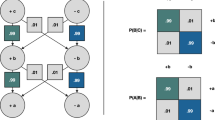Abstract
We extend the language of the classical syllogisms with the sentence-forms “At most 1 p is a q” and “More than 1 p is a q”. We show that the resulting logic does not admit a finite set of syllogism-like rules whose associated derivation relation is sound and complete, even when reductio ad absurdum is allowed.
Similar content being viewed by others
References
Bentham, G. (1827). Outline of a new system of logic, with a critical examination of Dr. Whately’s “Elements of Logic”. London: Hunt and Clarke.
Boole, G. (1868). Of propositions numerically definite. Transactions of the Cambridge Philosophical Society, XI(II), 396–411.
Boole, G. (1952). Collected logical works: Studies in logic and probability (Vol. 1). La Salle, IL: Open Court.
Corcoran, J. (1972). Completeness of an ancient logic. Journal of Symbolic Logic, 37(4), 696–702.
De Morgan, A. (1847). Formal Logic: Or, the calculus of inference, necessary and probable. London: Taylor and Walton.
Eisenbrand, F., & Shmonin, G. (2006). Carathéodory bounds for integer cones. Operations Research Letters, 34(5), 564–568.
Fogelin, R. J. (1976). Hamilton’s theory of quantifying the predicate—A correction. The Philosophical Quarterly, 26(105), 352–353.
Grattan-Guinness, I. (2000). The search for mathematical roots, 1870–1940: Logics, set theories and the foundations of mathematics from Cantor through Russell to Gödel. Princeton, NJ: Princeton University Press.
Hacker, E., & Parry, W. (1967). Pure numerical Boolean syllogisms. Notre Dame Journal of Formal Logic, 8(4), 321–324.
Hamilton, W. (1860). Lectures on logic (Vol. II). Edinburgh and London: William Blackwood and Sons.
Jevons, W. (1871). On a general system of numerically definite reasoning. Memoirs of the Manchester Literary and Philosophical Society (3rd Series), 4, 330–352.
Jevons, W. (1890). Pure logic and other minor works. London: Macmillan.
Murphree, W. (1998). Numerical term logic. Notre Dame Journal of Formal Logic, 39(3), 346–362.
Pratt-Hartmann, I. (2008). On the computational complexity of the numerically definite syllogistic and related logics. Bulletin of Symbolic Logic, 14(1), 1–28.
Pratt-Hartmann, I. (2009). No syllogisms for the numerical syllogistic. In: O. Grumberg, et al. (Eds.), Languages: From formal to natural (Vol. 5533 of Lecture Notes in Computer Science, pp. 192–203). Berlin: Springer.
Pratt-Hartmann, I. (2011). The Hamiltonian syllogistic. Journal of Logic, Language and Information, 20(4), 445–474.
Pratt-Hartmann, I., & Moss, L. S. (2009). Logics for the relational syllogistic. Review of Symbolic Logic, 2(4), 647–683.
Smiley, T. (1973). What is a syllogism? Journal of Philosophical Logic, 2, 135–154.
Author information
Authors and Affiliations
Corresponding author
Rights and permissions
About this article
Cite this article
Pratt-Hartmann, I. The Syllogistic with Unity. J Philos Logic 42, 391–407 (2013). https://doi.org/10.1007/s10992-012-9229-3
Received:
Accepted:
Published:
Issue Date:
DOI: https://doi.org/10.1007/s10992-012-9229-3




